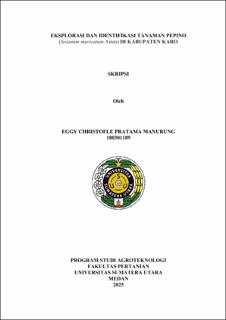Eksplorasi dan Identifikasi Tanaman Pepino (Solanum muricatum Aiton) di Kabupaten Karo
Exploration and Identification of Pepino (Solanum muricatum Aiton) in Karo Regency

Date
2025Author
Manurung, Eggy Christofle Pratama
Advisor(s)
Siregar, Luthfi Aziz Mahmud
Metadata
Show full item recordAbstract
Pepino (Solanum muricatum Aiton) fruit is known for its medicinal properties, which include benefits for diabetes, stroke, hypertension, hemorrhoids, cancer, kidney disorders, constipation, and gastritis. The cultivation of pepino in North Sumatra, particularly in Karo Regency, remains limited due to a lack of public awareness about the fruit and its cultivation methods. Therefore, research focusing on the exploration and identification of pepino plants in Karo Regency is necessary. This study aims to explore and identify pepino (Solanum muricatum Aiton) plants in Karo Regency. The research was conducted in three sub-districts: Dolat Rayat, Berastagi, and Tiga Panah, from August to October 2024. Sampling locations were determined using the snowball sampling method, while samples were collected using a descriptive survey method based on the descriptor guidelines for pepino plants published by the International Union for the Protection of New Varieties of Plants (UPOV), with an accidental sampling technique. The results revealed 27 pepino plant samples collected from three sub-districts, with three villages in each sub-district and three samples taken from each village. The closest genetic relationship was found between samples DR3 and R3, with a genetic similarity coefficient of 0,73. Samples DR3 and R3 shared similarities in 16 out of 22 qualitative and quantitative parameters. Meanwhile, the farthest genetic relationship was observed between cluster I with cluster II, with a genetic similarity coefficient of 0,34.
Collections
- Undergraduate Theses [3569]
